
Ducati Diavel Service Manual: Topping up the electrolyte
Warning
Before carrying out any operations on the battery, keep in mind the safety standards (sect.1 - 3, General safety rules).
The electrolyte in the battery is toxic and can cause burns if it comes into contact with the skin because it contains sulphuric acid. Wear protective clothing, a face-mask and goggles when adding electrolyte. If the liquid comes into contact with the skin, wash thoroughly with cold water. If it comes into contact with the eyes, wash thoroughly with water for 15 minutes and consult an ophthalmologist. In the event of accidental ingestion, drink large quantities of water or milk, and continue with milk of magnesia, beaten egg or vegetable oil. Do not allow sparks, flames, cigarettes or any other heat source to come near the battery, as it produces explosive gases. When recharging or using the battery indoors, make sure that the room is adequately ventilated. Do not inhale the gases produced during recharging. Keep out of reach of children.
Place the battery on a flat surface. Remove the protective film (1).
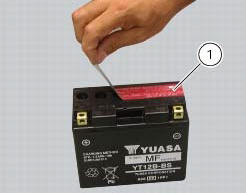
Warning
Make certain that the electrolyte is of the specific type for your battery.
Remove the container with the electrolyte from the plastic bag. Remove the cap strip (3) from the container (2).
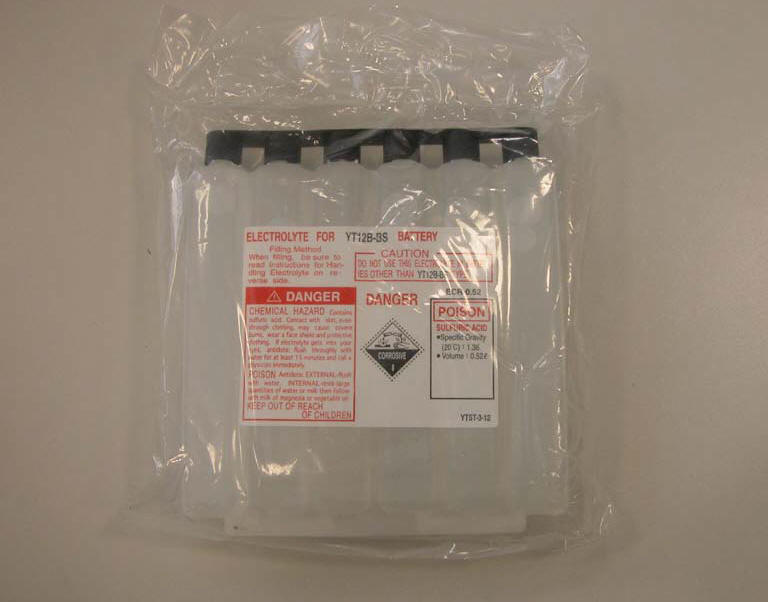
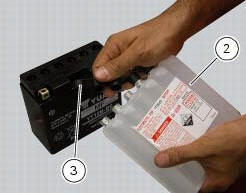
Important
Keep the cap strip (3) to hand because it will be used later as plugs for the battery cells.
Warning
Do not peel or perforate the sealed areas.
Place the electrolyte container (2) upside down. Align the six sealed elements with the six filler holes on the battery.
Push the container (2) downwards with sufficient force to break the seals and allow the liquid to flow out.
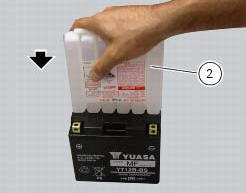
Note
Do not tilt the electrolyte container as this could interrupt the flow temporarily or even permanently.
Make certain that air bubbles emerge from all six filler holes. Leave the container in this position for at least twenty minutes.
If no bubbles emerge from one of the holes, tap gently on the bottom of the respective container.
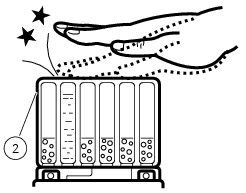
Important
Never move the container away from the battery. Do not cut or puncture the liquid container.
Make sure that all the electrolyte has flowed out. Carefully extract the container (2) from the battery.
Fit the cap bar (3) -previously removed from the electrolyte container (2)- to the battery, ensure the caps plug off all filler holes.
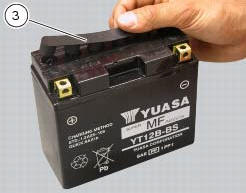
3 -12 Ah batteries: leave to stand for at least 30 min.
12 Ah batteries: leave to stand for at least 1 hour.
Rest the cap strip on the filler holes without fixing it. Recharge the battery as described in the paragraph "recharging the battery".
Note
When using an automatic reduction battery charger, check that the charger current (ampere) is equal or higher than the value of standard charging system (std) indicated on the battery itself.
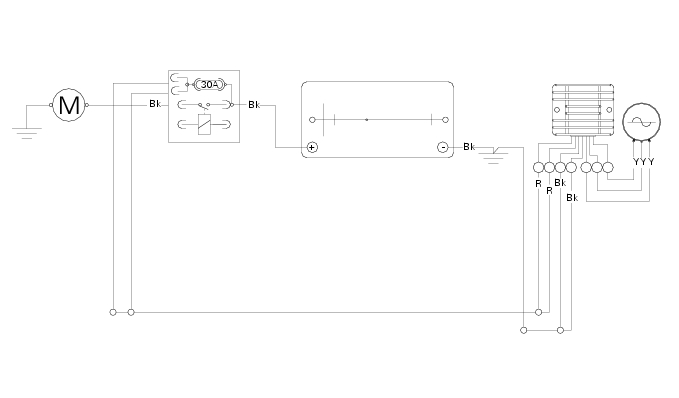
Press firmly downwards with both hands until the caps are firmly in place (do not use a hammer).
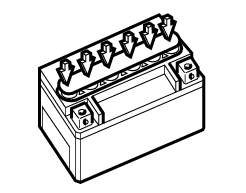
 Recharging the battery
Recharging the battery
Examine the label on the battery showing the check intervals in order to
determine when to test the voltage.
Charge the battery if the open circuit voltage is lower than 12.8 V. Leaving
the b ...
 Battery
Battery
Battery safety rules
Warning
Before carrying out any operations on the battery, keep in mind the
safety standards (sect. 1 - 3, General safety rules).
When under charge, batteries produce explo ...
Other materials:
Removal of the clutch transmission unit
Warning
The manufacturer of the clutch transmission unit (15) advises
against servicing of its internal parts due to the safetycritical
nature of this component.
Incorrect overhaul of these critical safety components can endanger rider and
passenger safety.
The only components that shoul ...
Refitting the oil pump
If removed, apply specific threadlocker on the bushing (7) outer thread, and
screw it in the crankcase half, observing the
height.
Position the reference bushings (15) and the oil sealing o-rings (2) and (4)
according to the crankcase lubrication
channels.
Position the oil pump on th ...
Renewal of the headlight
Disconnect the headlight connectors (a) from the main wiring (refer to the
tables of paragraph "routing of wiring on
frame", sect. 6 - 1).
Loosen nuts (2) that fix the front optical unit to the bottom yoke, and
recover the washers (3).
Remove the complete front optical unit by sliding ...